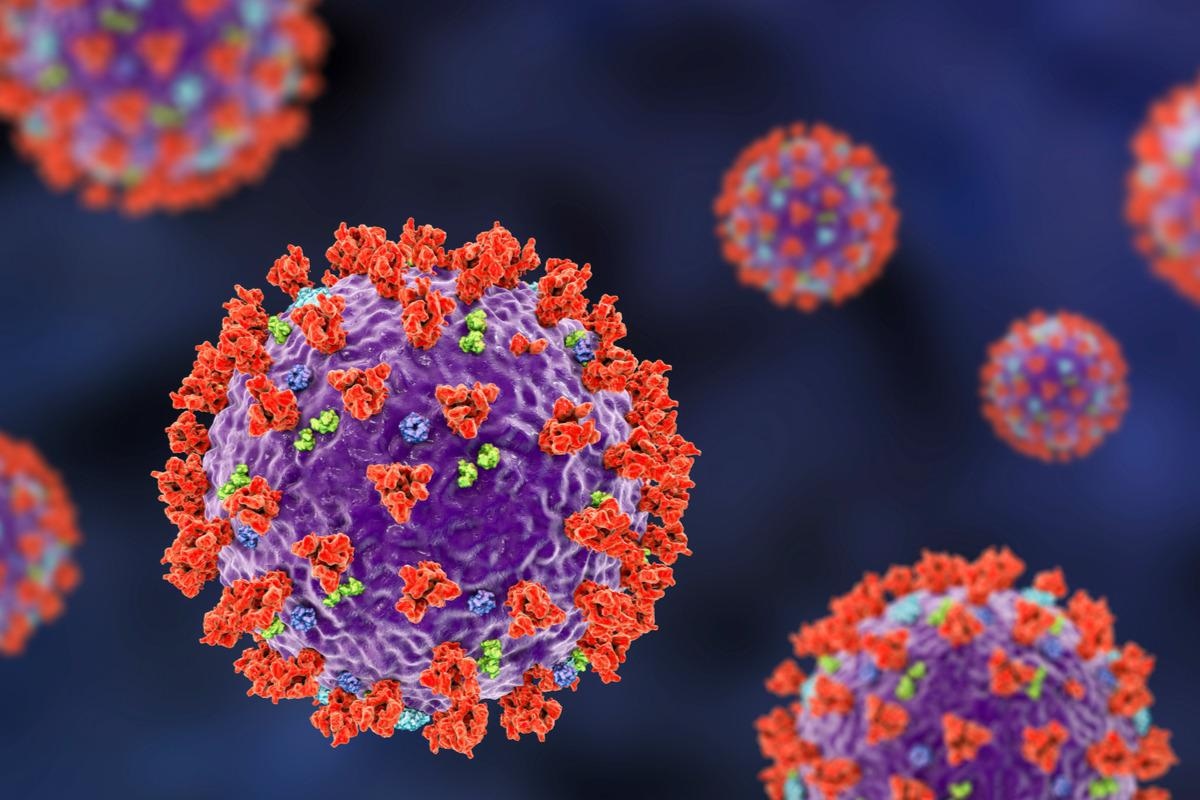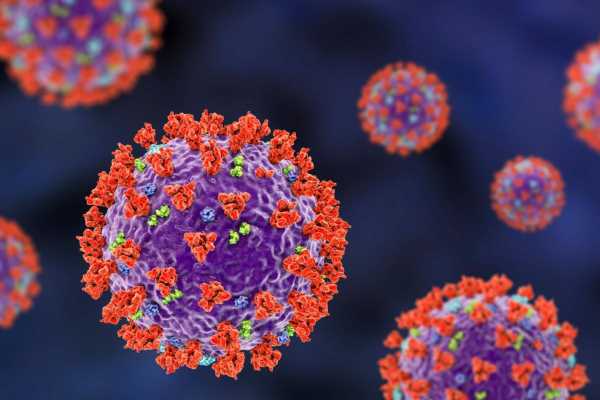In a study published in the latest issue of the journal Cell Reports Medicine, a team of researchers developed a vaccine candidate with severe acute respiratory syndrome coronavirus 2 (SARS-CoV-2) spike (S) glycoprotein coated onto lipid vesicles (S-LV) which resembled virus-like particles (VLPs).
Following natural SARS-CoV-2 infection, the magnitude of antibody responses to S protein vary greatly and correlate with disease severity and duration. Basal responses persist for months or decline within weeks after infection, as observed in asymptomatic individuals. Coronavirus disease 2019 (COVID-19) vaccines, thus, should aim at inducing not just protective but long-lasting immunity for better protection against SARS-CoV-2.
 Study: Immunization with synthetic SARS-CoV-2 S glycoprotein virus-like particles protects Macaques from infection. Image Credit: Kateryna Kon/Shutterstock
Study: Immunization with synthetic SARS-CoV-2 S glycoprotein virus-like particles protects Macaques from infection. Image Credit: Kateryna Kon/Shutterstock
The vaccine candidates based on the S subunit have shown varied neutralizing antibody responses in preclinical testing, which further increased to confer better immune protection against SARS-CoV-2 upon using self-assembling strategies for S or receptor-binding domain (RBD).
Under in vivo conditions, liposomes may be used to present antigens, as they have high multivalency, stability, and prolonged circulating half-life. When coated with viral glycoproteins such as HIV-1 envelope (ENV), liposomes may also induce more efficient immune responses and elicit effective B cell activation for the development of germinal centers (GC) by presenting multivalent ENV trimers. S-LV-induced antibodies have been shown to provide in vivo protection against the SARS-CoV-2 in small animals and non-human primates, such as macaques, hence are in different phases of clinical development.
About the study
In the present study, the researchers linked SARS-CoV-2 S to liposomes to engineer synthetic S-LVs with controlled diameters.
SARS-CoV-2 S glycoprotein of the wild-type SARS-CoV-2 strain was not stable due to its tendency to spontaneously switch into its post-fusion conformation. For enhanced stability, it was mutated at two proline sites to create a ‘2P’ version but still showed limited stability, which researchers overcame by using formaldehyde cross-linking that increased the thermostability to 65°C, preserving the native S conformation over extended storage periods. To further enhance the stability of S, they engineered the S 6P version, which had six proline mutations to increase its thermostability to 50°C.
The researchers used a small group of cynomolgus macaques immunized with S-LVs, which produced high S-specific antibody titers and TH1 CD4+ T cell responses.
In the past studies, the macaque animal model has demonstrated the induction of innate, cellular, and humoral responses upon infection, conferring partial protection against SARS-CoV-2 reinfection.
Currently used S-specific mRNA vaccines, such as Pfizer/BioNTech BNT162b2, have also shown efficacy in the macaque model.
Findings
S-LVs showed similar immunogenic properties and induced potent neutralizing responses in cynomolgus macaques.
Subsequently, post-immunization, there were no signs of SARS-CoV-2 replication in the upper and lower respiratory tracts of the test animals at a dose comparable or lower than in previous studies, including characteristic clinical COVID-19 signs, such as lymphopenia and lung damage.
When test animals were challenged with SARS-CoV-2 post four doses of S-LV immunization, they appeared completely protected against infection. The genomic RNA (gRNA) was not detected in their nasal and tracheal swabs, nor broncho-alveolar lavages (BAL), suggesting that vaccination with S-LVs prevented virus shedding and transmission, and provided sterilizing immunity.
Sterilizing immunity is correlated with mucosal antibody responses that protect the upper respiratory tract from infection. Significant levels of IgG and IgA were detected in the nasopharyngeal fluids at the time of viral challenge; the researchers thus concluded that S-LVs induced sterilizing protection by eliciting mucosal immune responses.
The antibody titers induced by licensed vaccines, including adenovirus-based AstraZeneca ChAdOx1 and mRNA vaccine Pfizer/BioNTech BNT162b2, are 10-20 times lower compared to the S-LVs in macaques studies. Further, the Moderna mRNA-1273 vaccine (Moderna) induced similar or higher titers in macaque studies.
Overall, these findings suggested that S-LVs are potential vaccine candidates for further evaluation in clinical trials and may emerge as safe protein-based COVID-19 vaccines.
S-LV vaccination also potently neutralized Alpha, Beta, and Gamma pseudovirus variants, although the median ID50 of Beta and Gamma neutralization were 20- and five-fold lower after the second immunization compared to wild-type SARS-CoV2 (WT) and Alpha pseudovirus variant.
The third vaccine dose boosted neutralization of Beta and Gamma, with an observed reduction in potency of six-fold for Beta and 3-fold for Gamma compared to WT.
Conclusions
Overall, these findings presented S-LV-based vaccines as an effective candidate for conferring protection in a macaque model. The test animals were challenged with SARS-CoV-2 after the fourth vaccine dose, which did not boost Ab or neutralization titers.
The neutralization data showed that these animals might have developed protective immunity soon after receiving two vaccine doses.
Moreover, the third vaccine dose increased their S-protein neutralization titers more significantly than RBD-specific titers, suggesting an increase of non-RBD antibodies that may have been beneficial for neutralization of different SARS-CoV-2 variants.
The N-terminal domain (NTD) region within S protein is the target for mutation in new SARS-CoV-2 variants, whereas S2 or other epitopes are less susceptible to mutations due to conformational constraints. An important takeaway for future vaccination strategies is that they should target boosting non-RBD antibodies to compensate for the loss of neutralization activity targeting RBD in SARS-CoV-2 variants.
More importantly, SARS-CoV-2 memory B cells were persistent for a long time in convalescent and mRNA-vaccinated individuals, supporting potential booster vaccination strategies.
- Sulbaran, G., et al. (2022). Immunization with synthetic SARS-CoV-2 S glycoprotein virus-like particles protects Macaques from infection. Cell Reports Medicine. doi: https://doi.org/10.1016/j.xcrm.2022.100528 https://www.cell.com/cell-reports-medicine/pdf/S2666-3791(22)00028-3.pdf?_returnURL=https%3A%2F%2Flinkinghub.elsevier.com%2Fretrieve%2Fpii%2FS2666379122000283%3Fshowall%3Dtrue
Posted in: Medical Science News | Medical Research News | Disease/Infection News
Tags: Adenovirus, Animal Model, Antibodies, Antibody, B Cell, CD4, Cell, Coronavirus, Coronavirus Disease COVID-19, covid-19, Cross-Linking, Efficacy, Formaldehyde, Genomic, Glycoprotein, HIV, HIV-1, immunity, Immunization, in vivo, Liposomes, Lymphopenia, Medicine, Mutation, Nasopharyngeal, Preclinical, Preclinical Testing, Proline, Protein, Pseudovirus, Receptor, Respiratory, RNA, SARS, SARS-CoV-2, Severe Acute Respiratory, Severe Acute Respiratory Syndrome, Syndrome, Vaccine, Virus

Written by
Neha Mathur
Neha Mathur has a Master’s degree in Biotechnology and extensive experience in digital marketing. She is passionate about reading and music. When she is not working, Neha likes to cook and travel.
Source: Read Full Article
